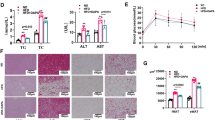Abstract
Peroxisome proliferator-activated receptor-γ (PPARγ) is essential for adipogenesis. Since EDF-1 is a cofactor of PPARγ, we investigated the molecular cross-talk between EDF-1 and PPARγ in adipogenesis. While EDF-1 was not modulated during differentiation of 3T3-L1 cells, it co-immunoprecipitated with PPARγ. Silencing EDF-1 by shRNAs inhibited the differentiation in adipocytes of 3T3-L1 cells, as detected by the staining of intracellular triglycerides and the expression of the PPARγ target gene aP2. Accordingly, we found that anti-EDF-1 shRNAs decreased ligand dependent activation of PPARγ in 3T3-L1 transiently transfected with a vector expressing luciferase under the control of a PPARγ responsive consensus. To rule out that this inhibition is due to the concomitant downregulation of PPARγ levels, we overexpressed PPARγ in 3T3-L1 silencing EDF-1 and found a decrease of ligand dependent activation of PPARγ, in spite of the high amounts of PPARγ. These results demonstrate that EDF-1 is required for PPARγ transcriptional activation during 3T3-L1 differentiation.






Similar content being viewed by others
References
Rosen ED, Walkey CJ, Puigserver P, Spiegelman BM (2000) Transcriptional regulation of adipogenesis. Genes Dev 14:1293–1307
Gurnell M (2005) Peroxisome proliferator-activated receptor gamma and the regulation of adipocyte function: lessons from human genetic studies. Best Pract Res Clin Endocrinol Metab 19:501–523
Knouff C, Auwerx J (2004) Peroxisome proliferator-activated receptor-gamma calls for activation in moderation: lessons from genetics and pharmacology. Endocr Rev 25:899–918
Evans RM, Barish GD, Wang YX (2004) PPARs and the complex journey to obesity. Nat Med 10:355–361
Rosen ED, Spiegelman BM (2001) PPARgamma: a nuclear regulator of metabolism, differentiation, and cell growth. J Biol Chem 276:37731–37734
Lehrke M, Lazar MA (2005) The many faces of PPARgamma. Cell 123:993–999
Rosenfeld MG, Lunyak VV, Glass CK (2005) Sensors and signals: a coactivator/corepressor/epigenetic code for integrating signal-dependent programs of transcriptional response. Genes Dev 20:1405–1428
Brendel C, Gelman L, Auwerx J (2002) Multiprotein bridging factor-1 (MBF-1) is a cofactor for nuclear receptors that regulate lipid metabolism. Mol Endocrinol 16:1367–1377
Dragoni I, Mariotti M, Consalez G, Soria M, Maier JAM (1998) EDF-1, a novel gene product downregulated in human endothelial cell differentiation. J Biol Chem 273:31119–31124
Mariotti M, Avon E, De Benedictis L, Maier JAM (2000) Interaction between endothelial differentiation-related factor-1 and calmodulin in vitro and in vivo. J Biol Chem 275:24047–24051
Ballabio E, Mariotti M, De Benedictis L, Maier JAM (2004) The dual role of EDF-1 in the cytosol and in the nucleus: modulation by PKA. Mol Cell Life Sci 61:1069–1074
Bernardini D, Mariotti M, Ballabio E, Maier JAM (2005) Differential expression of EDF-1 and endothelial nitric oxide synthase by proliferating, quiescent and senescent microvascular endothelial cells. Biochim Biophys Acta Mol Cell Res 1745:265–272
Mishima M, Ozaki J, Ikegami T, Kabe Y, Goto M, Ueda H, Hirose S, Handa H, Shirakawa M (1999) Resonance assignments, secondary structure and 15 N relaxation data of the human transcriptional coactivator hMBF1 (57–148). J Biomol NMR 14:373–376
Miotto B, Struhl K (2006) Differential gene regulation by selective association of transcriptional coactivators and bZIP DNA-binding domains. Mol Cell Biol 26:5969–5982
Stephens JM, Lee J, Pilch PF (1997) Tumor necrosis factor-alpha-induced insulin resistance in 3T3–L1 adipocytes is accompanied by a loss of insulin receptor substrate-1 and GLUT4 expression without a loss of insulin receptor-mediated signal transduction. J Biol Chem 272:971–976
Tzameli I, Fang H, Ollero M, Shi H, Hamm JK, Kievit P, Hollenberg AN, Flier JS (2004) Regulated production of a peroxisome-proliferator activated receptor-γ ligand during an early phase of adipocyte differentiation in 3T3–L1 adipocyte. J Biol Chem 279:1093–1102
Sentinelli F, Filippi E, Cavallo MG, Romeo S, Fanelli M, Baroni MG (2006) The G972R variant of the insulin receptor substrate-1 gene impairs insulin signaling and cell differentiation in 3T3–L1 adipocytes; treatment with a PPARgamma agonist restores normal cell signaling and differentiation. J Endocrinol 188(2):271–285
Metzger D, Imai T, Jiang M, Takukawa R, Desvergne B, Wahli W, Chambon P (2005) Functional role of RXRs and PPAR gamma in mature adipocytes. Prostaglandins Leukot Essent Fatty Acids 73(1):51–58
Takemaru K, Li FQ, Ueda H, Hirose S (1997) Multiprotein bridging factor 1 (MBF1) is an evolutionarily conserved transcriptional coactivator that connects a regulatory factor and TATA element-binding protein. Proc Natl Acad Sci USA 94:7251–7256
Wu Z, Xie Y, Bucher NL, Farmer SR (1995) Conditional ectopic expression of C/EBP beta in NIH-3T3 cells induces PPAR gamma and stimulates adipogenesis. Genes Dev 9:2350–2363
Hu E, Tontonoz P, Spiegelman BM (1995) Transdifferentiation of myoblasts by the adipogenic transcription factors PPAR gamma and C/EBP alpha. Proc Natl Acad Sci USA 92:9856–9860
Albright SR, Tjian R (2000) TAFs revisited: more data reveal new twists and confirm old ideas. Gene 242:1–13
Fox KE, Fankell DM, Erickson PF, Majka SM, Crossno JT Jr, Klemm DJ (2006) Depletion of cAMP-response element-binding protein/ATF1 inhibits adipogenic conversion of 3T3–L1 cells ectopically expressing CCAAT/enhancer-binding protein (C/EBP) alpha, C/EBP beta, or PPAR gamma 2. J Biol Chem 281:40341–40353
Takahashi Y, Inoue J, Kagechika H, Sato R (2009) ApoC-III gene expression is sharply increased during adipogenesis and is augmented by retinoid X receptor (RXR) agonists. FEBS Lett 583:493–497
Author information
Authors and Affiliations
Corresponding author
Additional information
M. Leidi and M. Mariotti have contributed equally to this work.
Rights and permissions
About this article
Cite this article
Leidi, M., Mariotti, M. & Maier, J.A.M. Transcriptional coactivator EDF-1 is required for PPARγ-stimulated adipogenesis. Cell. Mol. Life Sci. 66, 2733–2742 (2009). https://doi.org/10.1007/s00018-009-0069-4
Received:
Accepted:
Published:
Issue Date:
DOI: https://doi.org/10.1007/s00018-009-0069-4




